Emotional Induction Among Firefighters Using Audiovisual Stimuli: An Experimental Study
Abstract
1. Introduction
1.1. Theoretical Context: Emotions and Regulation
1.2. Defining the Operational Context
- Dynamism: Situations evolve rapidly and unpredictably, requiring constant reassessment of priorities.
- Uncertainty: Incomplete or unreliable information amplifies the challenges of decision-making.
- Risk: Physical dangers to responders and victims increase emotional and cognitive pressure.
1.3. Specific Objectives of the Paper
- Evaluate the effectiveness of audiovisual stimuli in inducing realistic emotional states among firefighters by replicating the characteristics of the operational context. The emotions targeted by this research are stress (and its opposite: serenity), anger (towards the aggressor), and fear (for the victim or his own safety).
- Compare the emotional responses of different groups (firefighters, students) to these stimuli, considering their professional experience and exposure to stress.
2. Materials and Methods
2.1. Audiovisual Scenario
2.1.1. Introductory Phase (IP)
2.1.2. Scene 1 (SC1): Climbing the Stairs
- Pilot study: The audiovisual support pauses at the first cries, allowing participants to respond to the psychometric test associated with this initial scene. This pause lasts one minute, providing a moment for reflection and analysis.
- Immersive room: No interruption is planned. The cries continue to grow closer as the responders ascend to the landing, where one firefighter knocks on the door.
2.1.3. Scene 2 (SC2): Appearance of the Victim
- Pilot study: The audiovisual support pauses at this point to allow participants to complete the questionnaires for the scene.
- Immersive room: The audiovisual support continues uninterrupted, allowing viewers to stay fully immersed in the scene.
2.1.4. Scene 3 (SC3): A Piercing Scream
- Pilot study: The audiovisual support pauses after the girl’s scream to assess the emotional impact of the scene on participants.
- Immersive room: The audiovisual support also pauses after the scream, but a question appears in white text on a black background, asking firefighters to provide instructions for helping the injured woman within 15 s (Figure 4). This exercise aims to increase stress by engaging them in the task despite the heightened tension of the rescue situation. A 15-s countdown appears on screen, with a voice announcing the last ten seconds to intensify the sense of urgency.
2.1.5. Scene 4 (SC4): The Threatening Man
- Pilot study: The audiovisual support pauses after the child’s cry behind the door, allowing participants to complete the emotional questionnaire.
- Immersive room: The audiovisual simulation also pauses after the child’s cry, displaying a question in white on a black background, prompting firefighters to provide rescue instructions within 15 s. This exercise is designed to heighten stress by demanding rapid decision-making in a high-risk, uncertain scenario where the child’s life is at stake. A 15-s countdown is displayed, with a voice announcing the final ten seconds to further intensify the sense of urgency.
2.1.6. Behind-the-Scenes
2.1.7. Overall Summary
- Constant uncertainty in a constrained environment without direct visual clues (closed door, cries, ambiguous noises).
- Dynamic evolution of the situation (revelation that the child is alive after the door is closed), with unpredictable events requiring quick reactions.
- Threat posed by the armed man, highlighting a clear risk.
- Necessity to rescue the child, requiring rapid and coordinated intervention, typical of rescue missions in an operational setting.
2.2. Measurements
2.3. The Pilot Study
2.3.1. Participants
2.3.2. Procedure
2.4. The Immersive Room Study
2.4.1. Participants
2.4.2. Procedure
3. Results
3.1. Results of the Pilot Study
3.1.1. Statistical Choice on Outlier Data
3.1.2. Participants Emotional Profile
3.1.3. Emotional Responses Induced by the Video
3.1.4. Firefighters vs. Students Results on the Four Most Targeted Emotions: Stress, Fear, Anger and Serenity
3.1.5. Evolution of Firefighters’ Targeted Emotions During the Film
3.2. Emotional Responses Across Film Scenes and Behind-the-Scenes in the Immersive Room Study
Evolution of Targeted Emotions Throughout the Film
4. Discussion
4.1. Emotional Dynamics and Group-Specific Differences
4.2. Influence of the Immersive Environment
4.3. Ethical Considerations: The Role of the Behind-the-Scenes Segment
4.4. Practical Implications
4.5. Applications for Training
4.6. Limitations and Future Research
4.6.1. Methodological Limitations
4.6.2. Limitations Related to the Study Design
4.6.3. Future Research Directions
5. Conclusions and Perspectives
- Future studies should investigate how repeated exposure to immersive scenarios influences long-term emotional resilience and decision-making under pressure. Understanding the cumulative impact of this training approach will be key to optimizing its benefits.
- While this study primarily relied on self-reported measures, integrating physiological indicators (e.g., heart rate variability, skin conductance, eye-tracking) would enable a more objective assessment of emotional responses and provide a deeper understanding of emotional regulation mechanisms.
- Expanding the use of immersive audiovisual tools beyond firefighting could help assess their applicability in law enforcement, healthcare, military operations, and disaster response. Further research should explore how these tools can be adapted to suit the specific challenges and stressors faced by different professional groups.
- Future immersive simulations could incorporate interactive elements that require participants to actively make decisions and manage crises in real time. The integration of adaptive learning algorithms could personalize training experiences based on individual responses and emotional profiles.
- While the immersive room study provided a more realistic experience, future research should explore on-site training applications where simulations are conducted in environments that closely mimic actual emergency situations, such as training centers or field exercises.
Author Contributions
Funding
Institutional Review Board Statement
Informed Consent Statement
Data Availability Statement
Acknowledgments
Conflicts of Interest
References
- Gross, J.J. Antecedent- and Response-Focused Emotion Regulation: Divergent Consequences for Experience, Expression, and Physiology. J. Pers. Soc. Psychol. 1998, 74, 224–237. [Google Scholar] [CrossRef] [PubMed]
- Duque, A.; Cano-López, I.; Puig-Pérez, S. Effects of Psychological Stress and Cortisol on Decision Making and Modulating Factors: A Systematic Review. Eur. J. Neurosci. 2022, 56, 3889–3920. [Google Scholar] [CrossRef]
- Meiselman, H.L. Emotion Measurement: Theoretically Pure or Practical? Food Qual. Prefer. 2017, 62, 374–375. [Google Scholar] [CrossRef]
- Fernández-Aguilar, L.; Navarro-Bravo, B.; Ricarte, J.; Ros, L.; Latorre, J.M. How Effective Are Films in Inducing Positive and Negative Emotional States? A Meta-Analysis. PLoS ONE 2019, 14, e0225040. [Google Scholar] [CrossRef] [PubMed]
- Zupan, B.; Eskritt, M. Eliciting Emotion Ratings for a Set of Film Clips: A Preliminary Archive for Research in Emotion. J. Soc. Psychol. 2020, 160, 768–789. [Google Scholar] [CrossRef] [PubMed]
- Coehoorn, C.J.; Stuart-hill, L.A.; Abimbola, W.; Neary, J.P.; Krigolson, O.E. Firefighter Neural Function and Decision-Making Following Rapid Heat Stress. Fire Saf. J. 2020, 118, 103240. [Google Scholar] [CrossRef]
- Torres Fernández, D.; Blanca Moya, E.; Pérez Sánchez, R. Immersion and Emotional Arousal with Virtual Reality Videogames. Rev. Psicol. 2021, 39, 531–551. [Google Scholar] [CrossRef]
- Godé, C.; Lebraty, J.F. Improving Decision Making in Extreme Situations: The Case of a Military Decision Support System. Int. J. Technol. Hum. Interact. 2013, 9, 1–17. [Google Scholar] [CrossRef]
- Article L1424-2-Code Général Des Collectivités Territoriales-Légifrance. Available online: https://www.legifrance.gouv.fr/codes/article_lc/LEGIARTI000044374325 (accessed on 25 November 2024).
- Antoine-Santoni, F.; Rossi, J.-L.; Devichi, C.; Syssau, A.; Ortoli, P.-M.; Yakhloufi, A.; Meradji, S.; Mannes, Y.; Marcelli, T.; Chatelon, F.-J.; et al. CP2DIMG: An Innovative Research Program Aimed at Preparing Firefighters and Police Officers to Manage Emotions and Stress in Operational Contexts. Fire 2024, 7, 188. [Google Scholar] [CrossRef]
- Reis, V.; Neves, C. Simulations in Virtual Reality: Assessment of Firefighters’ Decision-Making Competence. Rev. Iberoam. Informática Educ. 2020, 31, 28–39. [Google Scholar]
- Mancuso, V.; Bruni, F.; Stramba-Badiale, C.; Riva, G.; Cipresso, P.; Pedroli, E. How Do Emotions Elicited in Virtual Reality Affect Our Memory? A Systematic Review. Comput. Hum. Behav. 2023, 146, 107812. [Google Scholar] [CrossRef]
- Izard, C.E. Differential Emotions Theory. In Human Emotions; Springer: Boston, MA, USA, 1977; pp. 43–66. [Google Scholar] [CrossRef]
- Cohen, S.; Williamson, G. Perceived Stress in a Probability Sample of the United States. In The Social Psychology of Health; Spacapan, S., Oskamp, S., Eds.; McGraw-Hill Education: Newbury Park, CA, USA, 1988; Volume 13, pp. 31–67. ISBN 080393162X. [Google Scholar]
- Christophe, V.; Antoine, P.; Leroy, T.; Delelis, G. Évaluation de Deux Stratégies de Régulation Émotionnelle: La Suppression Expressive et La Réévaluation Cognitive. Eur. Rev. Appl. Psychol. 2009, 59, 59–67. [Google Scholar] [CrossRef]
- Lakens, D. Sample Size Justification. Collabra Psychol. 2022, 8, 33267. [Google Scholar] [CrossRef]
- Leys, C.; Ley, C.; Klein, O.; Bernard, P.; Licata, L. Detecting Outliers: Do Not Use Standard Deviation around the Mean, Use Absolute Deviation around the Median. J. Exp. Soc. Psychol. 2013, 49, 764–766. [Google Scholar] [CrossRef]
- Osborne, J.W.; Overbay, A. The Power of Outliers (and Why Researchers Should ALWAYS Check for Them). Pract. Assess. Res. Eval. 2004, 9, 6. [Google Scholar]
- Sjöström, O.; Holst, D. Validity of a Questionnaire Survey: Response Patterns in Different Subgroups and the Effect of Social Desirability. Acta Odontol. Scand. 2002, 60, 136–140. [Google Scholar] [CrossRef] [PubMed]
- Marcel-Millet, P.; Ravier, G.; Grospretre, S.; Gimenez, P.; Freidig, S.; Groslambert, A. Physiological Responses and Parasympathetic Reactivation in Rescue Interventions: The Effect of the Breathing Apparatus. Scand. J. Med. Sci. Sports 2018, 28, 2710–2722. [Google Scholar] [CrossRef]
- Delplanque, S.; Sander, D. A Fascinating but Risky Case of Reverse Inference: From Measures to Emotions! Food Qual. Prefer. 2021, 92, 104183. [Google Scholar] [CrossRef]
- Perroni, F.; Guidetti, L.; Cignitti, L.; Baldari, C. Psychophysiological Responses of Firefighters to Emergencies: A Review. Open Sports Sci. J. 2014, 7, 8–15. [Google Scholar] [CrossRef]
- Mulally, T. An Experiential Journey: A Year of a Professor Using AI in the Classroom and Research. Int. J. Stud. Educ. Sci. (IJSES) 2024, 5, 246–256. [Google Scholar] [CrossRef]
- Wong, Q.J.J.; Moulds, M.L. Impact of Anticipatory Processing versus Distraction on Multiple Indices of Anxiety in Socially Anxious Individuals. Behav. Res. Ther. 2011, 49, 700–706. [Google Scholar] [CrossRef] [PubMed]
- Abbas, S.; Nichol, J.E.; Wong, M.S. Trends in Vegetation Productivity Related to Climate Change in China’s Pearl River Delta. PLoS ONE 2021, 16, e0245467. [Google Scholar] [CrossRef]
- Kourtesis, P. A Comprehensive Review of Multimodal XR Applications, Risks, and Ethical Challenges in the Metaverse. Multimodal Technol. Interact. 2024, 8, 98. [Google Scholar] [CrossRef]
- Parotte, C.; Flore, N.; Frenay, S. Training to Embrace Uncertainties? The “Pathway Evolution Process” Serious Game for Assessing Toxic Waste Program. J. Strateg. Trade Control 2024, 2, 2–23. [Google Scholar] [CrossRef]
- Tao, Y.; Liu, X.; Hou, W.; Niu, H.; Wang, S.; Ma, Z.; Bi, D.; Zhang, L. The Mediating Role of Emotion Regulation Strategies in the Relationship Between Big Five Personality Traits and Anxiety and Depression Among Chinese Firefighters. Front. Public Health 2022, 10, 901686. [Google Scholar] [CrossRef]
- Hellhammer, D.H.; Wüst, S.; Kudielka, B.M. Salivary Cortisol as a Biomarker in Stress Research. Psychoneuroendocrinology 2009, 34, 163–171. [Google Scholar] [CrossRef]
- Nikolovski, Z.; Vrdoljak, D.; Foretić, N.; Perić, M.; Pavlinović, V.; Perić, R.; Karanović, V. Levels of Stress in Volleyball Referees During Official Matches—The Influence of the Referee Role and Level of Competition. Sports 2024, 12, 319. [Google Scholar] [CrossRef]
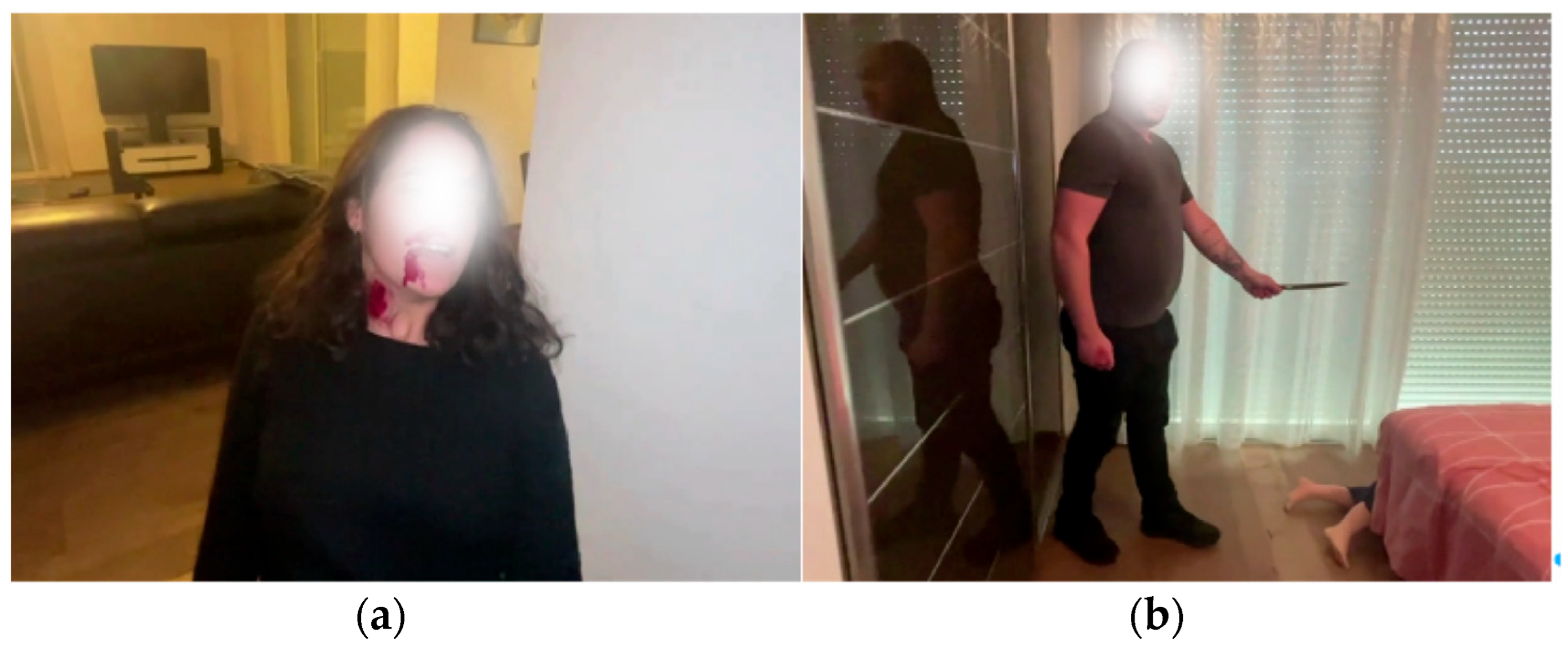
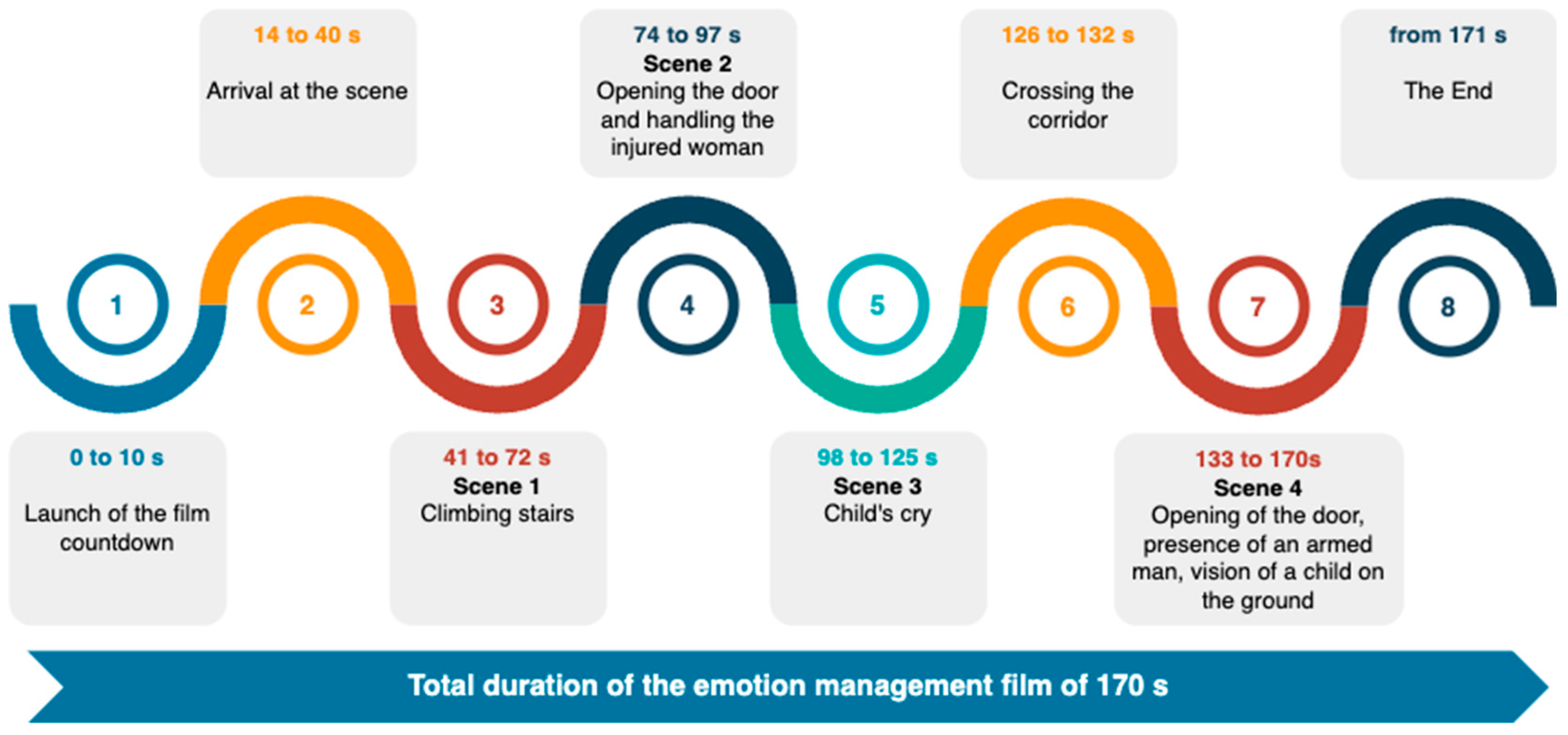




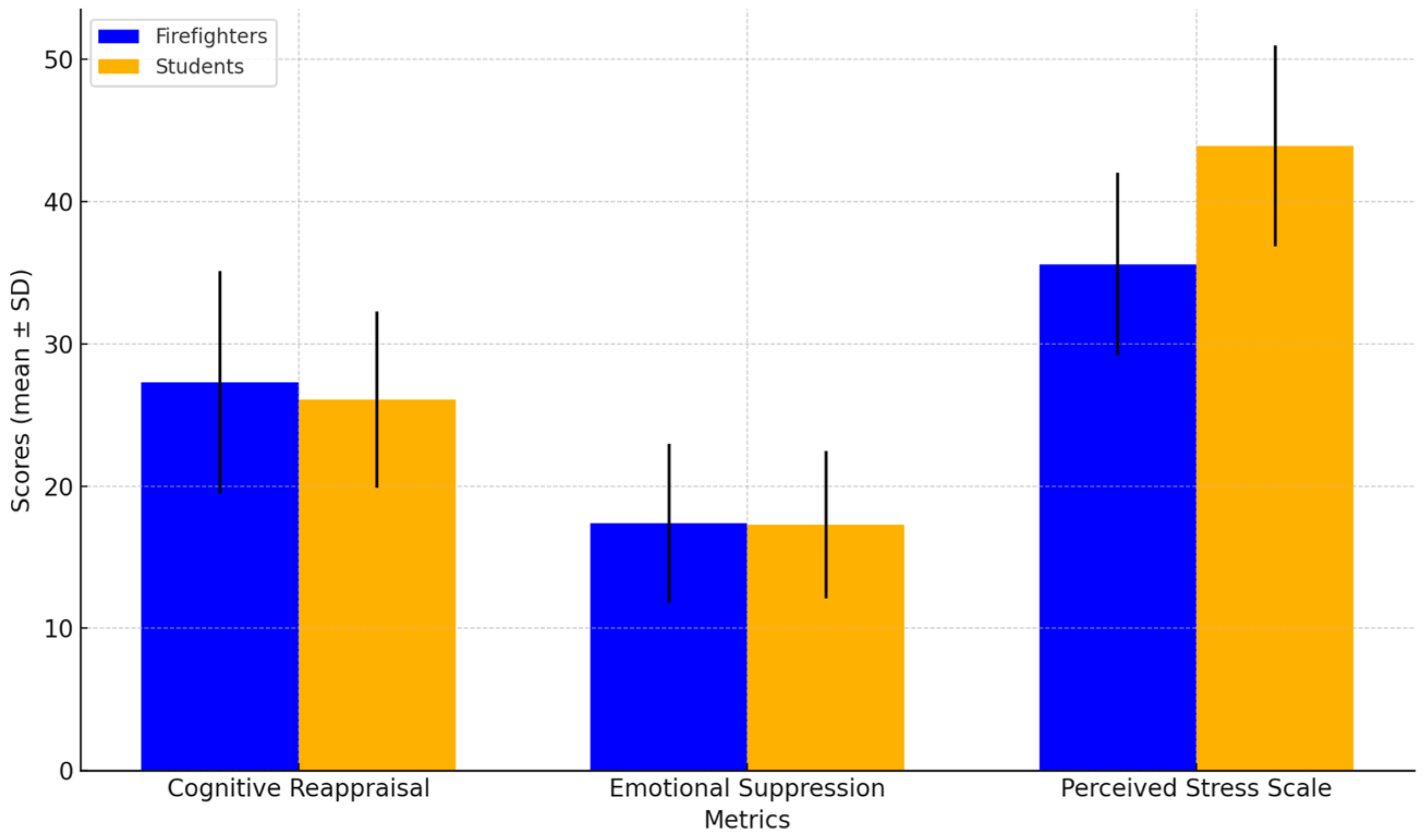
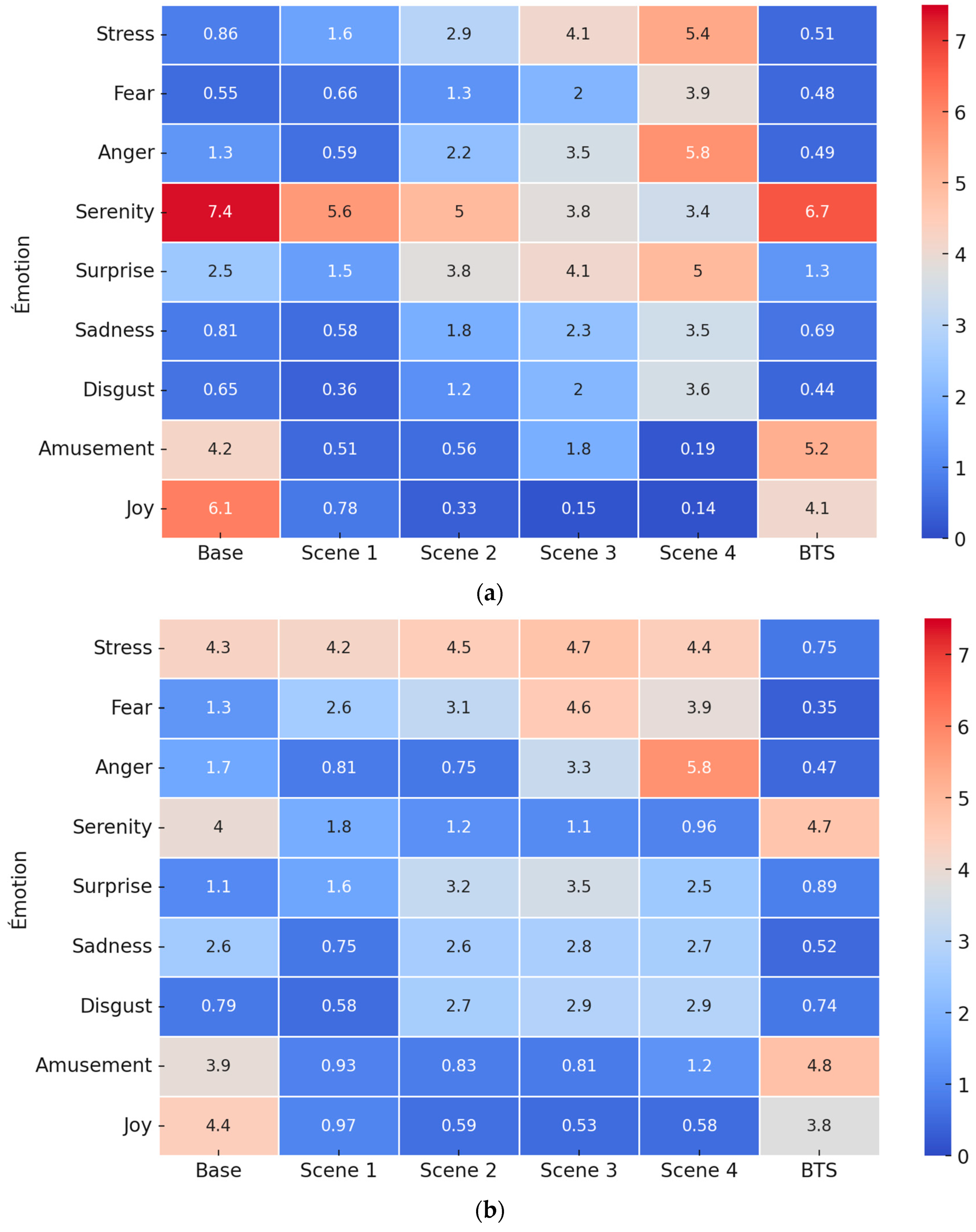
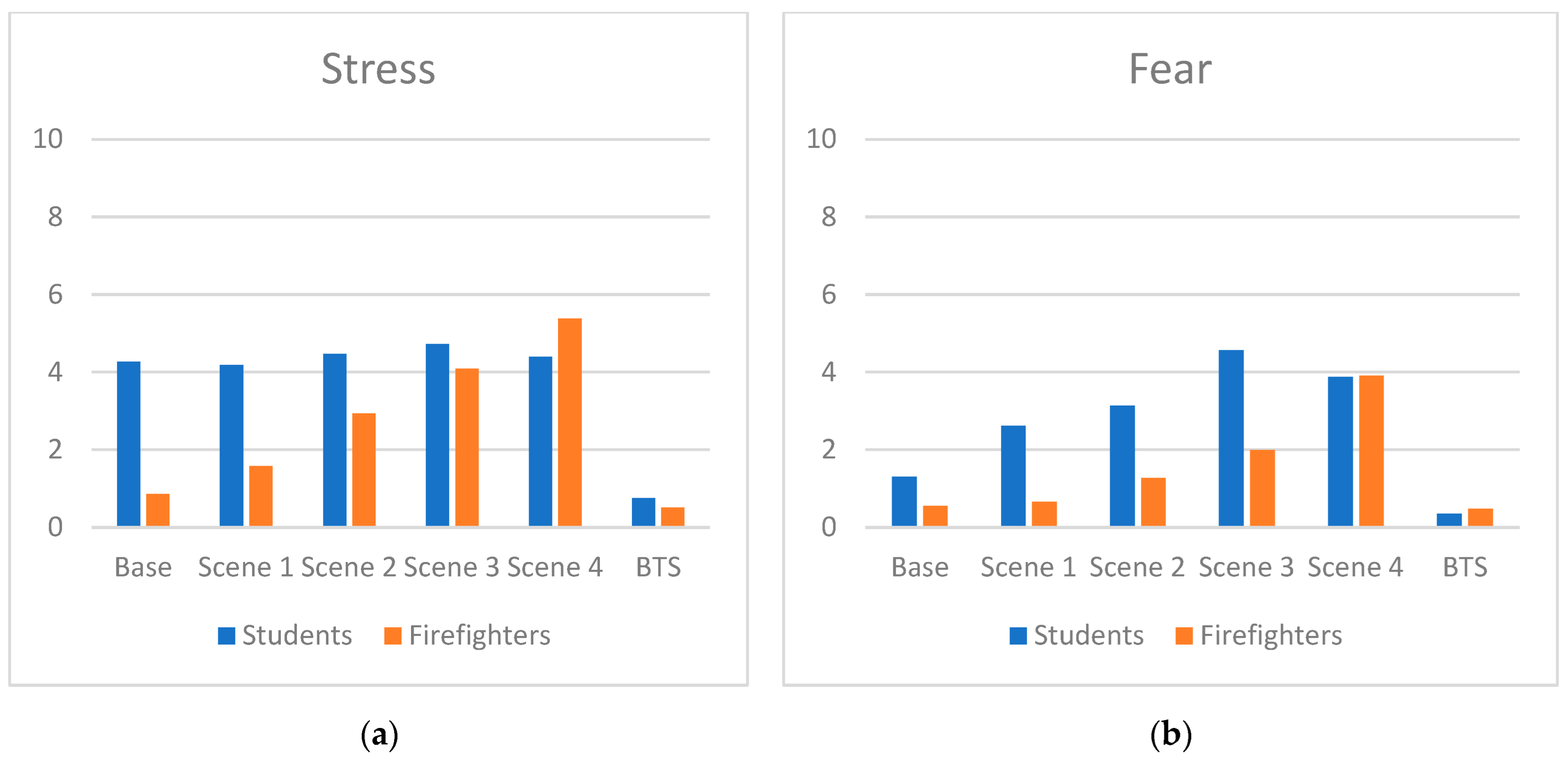
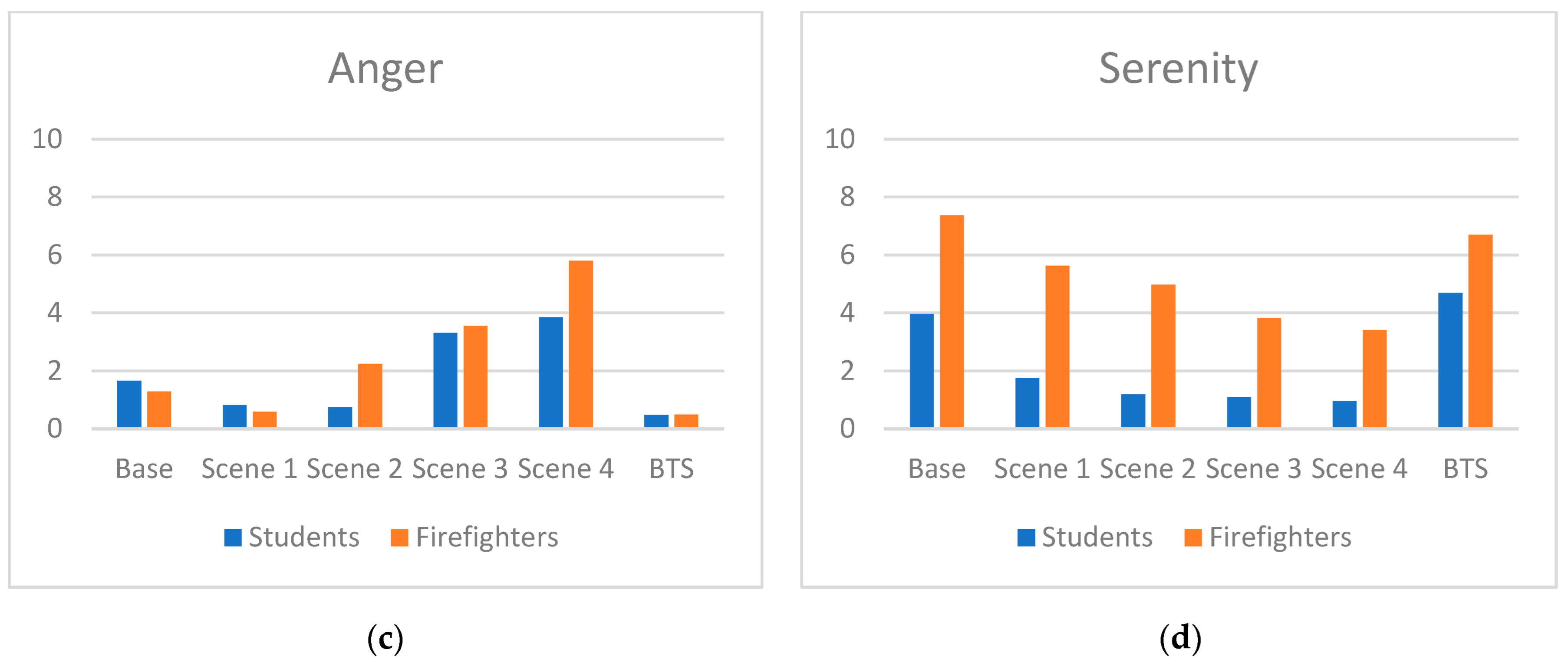


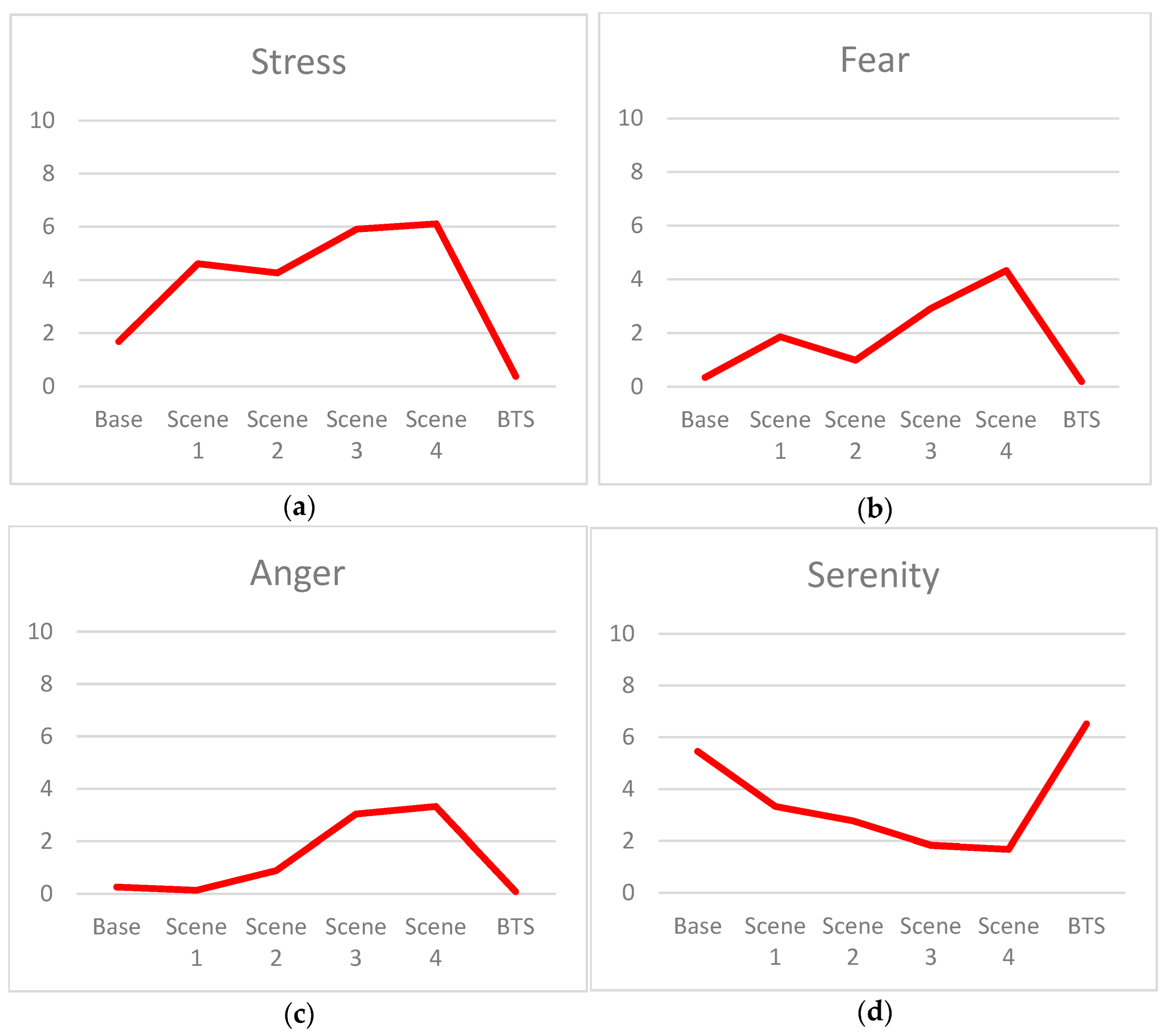
Disclaimer/Publisher’s Note: The statements, opinions and data contained in all publications are solely those of the individual author(s) and contributor(s) and not of MDPI and/or the editor(s). MDPI and/or the editor(s) disclaim responsibility for any injury to people or property resulting from any ideas, methods, instructions or products referred to in the content. |
© 2025 by the authors. Licensee MDPI, Basel, Switzerland. This article is an open access article distributed under the terms and conditions of the Creative Commons Attribution (CC BY) license (https://creativecommons.org/licenses/by/4.0/).
Share and Cite
Antoine-Santoni, F.; Syssau, A.; Devichi, C.; Rossi, J.-L.; Marcelli, T.; Chatelon, F.-J.; Yakhloufi, A.; Ortoli, P.-M.; Meradji, S.; Rossi, L.; et al. Emotional Induction Among Firefighters Using Audiovisual Stimuli: An Experimental Study. Fire 2025, 8, 111. https://doi.org/10.3390/fire8030111
Antoine-Santoni F, Syssau A, Devichi C, Rossi J-L, Marcelli T, Chatelon F-J, Yakhloufi A, Ortoli P-M, Meradji S, Rossi L, et al. Emotional Induction Among Firefighters Using Audiovisual Stimuli: An Experimental Study. Fire. 2025; 8(3):111. https://doi.org/10.3390/fire8030111
Chicago/Turabian StyleAntoine-Santoni, Frédéric, Arielle Syssau, Claude Devichi, Jean-Louis Rossi, Thierry Marcelli, François-Joseph Chatelon, Adil Yakhloufi, Pauline-Marie Ortoli, Sofiane Meradji, Lucile Rossi, and et al. 2025. "Emotional Induction Among Firefighters Using Audiovisual Stimuli: An Experimental Study" Fire 8, no. 3: 111. https://doi.org/10.3390/fire8030111
APA StyleAntoine-Santoni, F., Syssau, A., Devichi, C., Rossi, J.-L., Marcelli, T., Chatelon, F.-J., Yakhloufi, A., Ortoli, P.-M., Meradji, S., Rossi, L., Jauffret, J.-P., Chatton, S., & Grandjean-Kruslin, D. (2025). Emotional Induction Among Firefighters Using Audiovisual Stimuli: An Experimental Study. Fire, 8(3), 111. https://doi.org/10.3390/fire8030111








